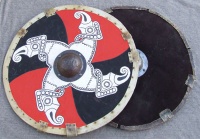Centre boss
A centre-boss shield was a type of round or oblong shield common in period. It has called a centre-boss because of the single central grip, protected by a metal boss. Most centre-boss shields actually had a hole in the centre with the grip flush to the shield, with the protective boss projecting outward from the shield face itself. Most centre-boss sheilds appear to be flat, but the best-quality centre-boss sheilds were lenticular (lens-shaped), that is, having a slightly conical shape back from the centre boss itself. As extent curved planks of wood for shields have been found with wooden shield bosses and flat boards with decorated iron bosses, personal or regional preferences may have dictated shape.
Lenticular centre-boss shields had the benefit of structural strength in addition to the resiliency of wood and rawhide, in the same way that a dome is stronger than a flat roof.
Historically these shields had metal or wooden bosses in the centre riveted to the wooden planked body which could be up to 95cm in diameter. Behind the shield is a wooden (sometimes covered in a metal sheath) or metal crossbar to act as a handle. The grip might also be covered in leather and the ends of the [[handle[[ might have a bronze termini. The face and back of the shield could be covered in leather or rawhide and painted. Housecarls were specifically instructed not to use leather from sheep for this purpose. Guiges were most commonly attached using rings and eyelets.
Centre-boss shields were commonly used by the Anglo-Saxons and Norse, but were known across the medieval world.
Centre Boss Shields in Combat
Centre-boss shields are handled very differently from other shield types (such as the kite shield or the heater shield) which are strapped to the arm. Tending to be light-weight, a centre-boss shield can be "punched" towards an incoming blow.
Centre boss shields were commonly used in shield walls, as they were the state of the art at the time of Alfred the Great, who perfected the shieldwall technique. Large centre-boss shileds allowed for the easy overlap of the edges of the shields, providing great strength and rigidity to the formation. With sufficient skill and training, the shieldwall can be quickly opened and closed to allow ofther fighters to slip through the ranks, either to charge or retreat.
